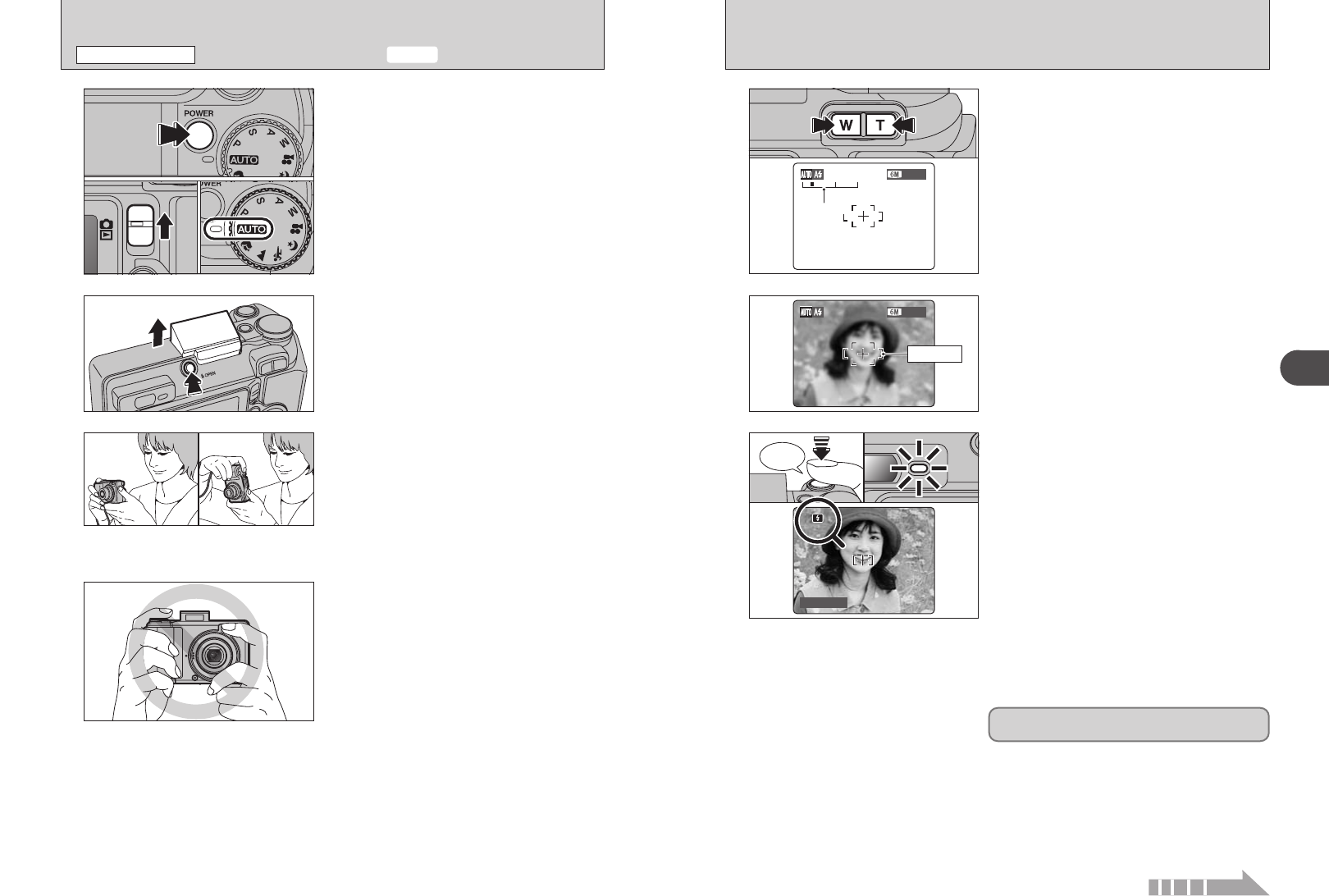
21
Using the Camera
2
20
2
3
1Press the “POWER” button to turn the camera
on.
2Set the Mode switch to “q”.
3Set the Mode dial to “B”.
h Focal range
Approx. 60 cm (2.0 ft.) to infinity
●
!
Use Macro mode for subjects closer than 60 cm (2.0 ft.)
(➡P.39).
●
!
When “7”, “-”, “q”
or “
=” appears, see P.112.
Press the Flash pop-up button to pop up the flash.
●
!
When the flash pops up, the image may disappear and go
dark briefly due to flash charging. The viewfinder lamp blinks
orange during charging.
●
!
If the flash is used in dusty conditions or when it is snowing,
white dots may appear in the image. This is due to the flash
reflecting off the dust particles or snowflakes. Use
Suppressed flash mode to fix the problem.
Brace your elbows against your sides and hold the
camera with both hands. Position your right thumb
so that it is handy for using the zoom.
●
!
Moving the camera while shooting gives a blurred picture
(camera shake). Use a tripod to avoid camera shake,
particularly for shots in the dark when the selected flash
mode is Suppressed flash.
●
!
There may be some uneven brightness at the lower edge of
the LCD monitor. This is normal and does not affect the
image.
4
●
!
Check that the lens is clean. If it is dirty, clean the lens as
informed on P.109.
Hold the camera so that your fingers or the strap do
not cover the lens, flash or flash control sensor. If
the lens, flash or flash control sensor is obscured,
the brightness (exposure) of your shot may be
incorrect.
5
Press “T” (telephoto) button to zoom in. Press “W”
(wide-angle) button to zoom out. A zoom bar
appears on the LCD monitor.
h Optical zoom focal length
(35 mm camera equivalent)
Approx. 32.5 mm-130 mm
Max. zoom scale: 4×
●
!
Zooming pauses briefly when the camera changes between
optical zoom and digital zoom (➡P.26). Press the same
Zoom button again to change zoom modes.
Zoom bar
1
01
02 03
TAKING PICTURES
(
B AUTO MODE
)
PHOTOGRAPHY MODE
Continued
Bebeep
●
!
The image shown on the LCD monitor before the picture is
taken may differ in brightness, color, etc. from the image
actually recorded. Play back the recorded image to check it
(➡P.27).
●
!
The subject may sometimes be difficult to see clearly on the
LCD monitor (in bright sunlight or dimly lit scenes, etc.). If so,
use the viewfinder to take the picture.
Use the LCD monitor to frame the shot so that the
subject fills the entire AF (Autofocus) frame.
6
Press the shutter button down halfway. When a
short double-beep is heard, the camera focuses on
your subject. The AF frame on the LCD monitor
becomes smaller and the camera sets the shutter
speed and aperture. The viewfinder lamp (green)
changes from blinking to lit.
●
!
If Ni-MH and alkaline batteries are being used together, or
the batteries are low on charge, camera may be turned off
without retracting the lens. At that time, set the Mode switch
to Playback mode (➡P.27). Then turn the camera on. After
the lens retracts, turn the camera off again. If the lens still
does not retract, fit new batteries or use the AC power
adapter (➡P.93).
●
!
When a short double-beep is heard and “{” appears on the
LCD monitor, the camera cannot focus.
●
!
Pressing the shutter button down halfway freezes the image
on the LCD monitor briefly. This image is not the recorded
image.
●
!
If “{” appears on the LCD monitor (e.g. the shot is too dark
for the camera to focus), try standing about 2 m (6.6 ft.) from
the subject to take the picture.
7
Before the flash fires, “∑” appears on the LCD
monitor.
AF frame


















